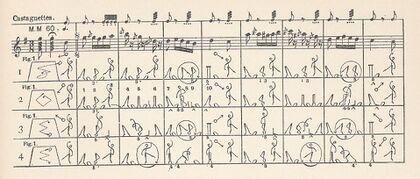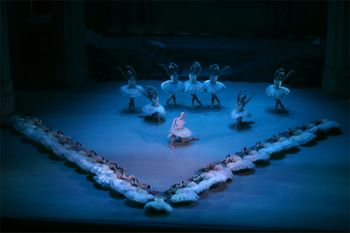تصميم الرقص
تصميم الرقص Choreography هو فن أو حرفة تصميم تسلسل حركات أجساد (أو صورهم) تتحدد فيها الحركة أو الشكل أو كلاهما. Choreography may also refer to the design itself. A choreographer is one who creates choreographies by practising the art of choreography, a process known as choreographing. It most commonly refers to dance choreography.[1]
In dance, choreography. may also refer to the design itself, which is sometimes expressed by means of dance notation. Dance choreography is sometimes called dance composition. Aspects of dance choreography include the compositional use of organic unity, rhythmic or non-rhythmic articulation, theme and variation, and repetition. The choreographic process may employ improvisation for the purpose of developing innovative movement ideas. In general, choreography is used to design dances that are intended to be performed as concert dance.
The art of choreography involves the specification of human movement and form in terms of space, shape, time and energy, typically within an emotional or non-literal context. Movement language is taken from the dance techniques of ballet, contemporary dance, jazz dance, hip hop dance, folk dance, techno, K-pop, religious dance, pedestrian movement, or combinations of these.
تصميم الرقص Choreography، هو فن تصميم تتابع الحركات من حيث الاتجاه أو الشكل أو كلاهما بطريقة محددة. ويمكن أن يقصد بها أيضا مفتاح الرقص.
أصل الاسم والتاريخ
The word choreography literally means "dance-writing"[2] from the Greek words "χορεία" (circular dance, see choreia) and "γραφή" (writing). It first appeared in the American English dictionary in the 1950s,[3] and "choreographer" was first used as a credit for George Balanchine in the Broadway show On Your Toes in 1936.[4] Before this, stage credits and movie credits used phrases such as "ensembles staged by",[5] "dances staged by",[6] or simply "dances by" to denote the choreographer.[4]
In Renaissance Italy, dance masters created movements for social dances which were taught, while staged ballets were created in a similar way. In 16th century France, French court dances were developed in an artistic pattern. In the 17th and 18th centuries, social dance became more separated from theatrical dance performances. During this time the word choreography was applied to the written record of dances, which later became known as dance notation, with the meaning of choreography shifting to its current use as the composition of a sequence of movements making up a dance performance.[2]
The ballet master or choreographer during this time became the "arranger of dance as a theatrical art", with one well-known master being of the late 18th century being Jean-Georges Noverre, with others following and developing techniques for specific types of dance, including Gasparo Angiolini, Jean Dauberval, Charles Didelot, and Salvatore Viganò. Ballet eventually developed its own vocabulary in the 19th century, and romantic ballet choreographers included Carlo Blasis, August Bournonville, Jules Perrot and Marius Petipa.[2]
Modern dance brought a new, more naturalistic style of choreography, including by Russian choreographer Michel Fokine (1880-1942)[2] and Isadora Duncan (1878-1927),[7] and since then styles have varied between realistic representation and abstraction. Merce Cunningham, George Balanchine, and Sir Frederick Ashton were all influential choreographers of classical or abstract dance, but Balanchine and Ashton, along with Martha Graham, Leonide Massine, Jerome Robbins and others also created representational works.[2] Isadora Duncan loved natural movement and improvisation. The work of Alvin Ailey (1931-1989), an African-American dancer, choreographer, and activist, spanned many styles of dance, including ballet, jazz, modern dance, and theatre.[7]
التقنيات
في الرقص، يُعرف تصميم الرقص على أنه تأليف الرقص. ويتم عمل مؤلفات الرقص بتطبيق واحدة أو أكثر من تقنيات التصميم الأساسية التالية:
- الارتجال، حيث يزود مصمم الرقص الراقصين "بنوتة" (أي توجيهات عامة) تعمل كإرشادات للحركة والشكل المرتجلين. على سبيل المثال، قد توجّه النوتة الراقص للانسحاب من راقص آخر، والذي يُطلب منه بدوره تجنب الانسحاب، أو قد تحدد تسلسلاً من الحركات التي يجب تنفيذها بطريقة مرتجلة على مدار جملة موسيقية، كما في تصميم رقصة الكونترا. تقدم النوتات المرتجلة عادةً مجالاً واسعاً لأن يفسرها الراقص بشكل شخصي.
- تصميم الرقص المخطط، حيث يقوم مصمم الرقص بإملاء الحركة والشكل بالتفصيل، مما يترك فرصة ضئيلة أو معدومة للراقص لتفسيرهما بشكل شخصي.[8]
Several underlying techniques are commonly used in choreography for two or more dancers:
- Mirroring - facing each other and doing the same
- Retrograde - performing a sequence of moves in reverse order
- Canon - people performing the same move one after the other
- Levels - people higher and lower in a dance
- Shadowing - standing one behind the other and performing the same moves
- Unison - two or more people doing a range of moves at the same time
Movements may be characterized by dynamics, such as fast, slow, hard, soft, long, and short.
تصميم رقص الباليه
قد يستوحي مصمم الرقصات فكرة الباليه من قصة أو رواية أو مسرحية أو مقطوعة موسيقية أو لوحة فنية، ثم يبدأ بتصميم الرقصات بما يتفق مع الشخصيات والأحداث. وتأتي الموسيقى في المرتبة الثانية بعد الرقصات، وقد يستخدم المصمم موسيقى موجودة بالفعل وهو الاتجاه الغالب في عروض الباليه لأنها أقل جهدًا وأقل تكلفة. وقد يتطلب الأمر تأليف موسيقى تتفق مع العروض.[9]
وفيما يختص بالزينة والرسومات (الديكور) فإن مسرح الباليه ذو طبيعة تختلف عن طبيعة الديكور المسرحي التقليدي إذ إن عرض الباليه يحتاج إلى أكبر مساحة ممكنة توفر للراقصين حرية الحركة، ولماكانت محاولات تقديم زينات واقعية مجسَّمة تتنافى مع ذلك المطلب الأساسي لأنها تحتل الشطر الأكبر من خشبة المسرح، فإن مصمم ديكور عروض الباليه يلجأ إلى اللوحات المرسومة على ستائر خلفية. وفي العصر الحديث يتجه الديكور إلى الاستغناء حتى عن اللوحات المرسومة والاعتماد على المؤثرات الموحية بالمشهد عن طريق استخدام قطع أو مناظر مفردة منتقاة بعناية للإيحاء بالمشهد أو الحالة المزاجية العامة. ومن أجل ذلك فإنه يتم استخدام الإمكانات الحديثة للإضاءة المسرحية إلى أقصى حد ممكن.
انظر أيضا
مقالات
- مفتاح الباليه
- قائمة مصممو الرقصات
- جمعية المخرجين المسرحيين ومصممي الرقص
- رقص ارتجالي
- ارتجال الاتصال
- مدير الحركة
تصنيفات
المصادر
- ^ "Definition of choreography". Dictionary.com. Retrieved 8 January 2022.
- ^ أ ب ت ث ج "choreography". Encyclopedia Britannica. Retrieved 8 January 2022.
- ^ "Frankie Manning: Lindy Hop Pioneer". Presented by Amanda Wilde. Radio Intersection. KUOW Puget Sound Public Radio. 2006-10-26. 12:31 minutes in.
- ^ أ ب Taper, Bernard (1996). George Balanchine: A Biography. University of California Press. ISBN 0-520-20639-8., p. 180
- ^
Mark Sandrich (Director) (1935). Top Hat (DVD). RKO Radio Pictures. Event occurs at 00:01:15. Retrieved 2007-08-08.
Ensembles Staged by Hermes Pan
- ^
Edward Cahn (Director) (1942). Our Gang in "Melodies Old and New" (DVD). Metro-Goldwyn-Mayer. Event occurs at 00:00:20. Retrieved 2007-08-07.
Dancer Staged by Steven Granger and Gladys Rubens
- ^ أ ب "Choreography: What It Is and How to Get Started". Skillshare. 24 June 2021. Retrieved 8 January 2022.
- ^ "Glossary (dance)". UCI Wiki. Electronic Educational Environment (EEE). Retrieved 2012-02-19.
- ^ "الباليه". الموسوعة المعرفية الشاملة. Retrieved 2011-05-02.
قراءات إضافية
- Blom, L, A. and Tarin Chaplin, L. (1989) The Intimate Act of Choreography. Dance Books. ISBN 0-8229-5342-0
- Ellfeldt, L. (1998) A Primer for Choreographers . Waveland Press. ISBN 0-88133-350-6
- Minton, S, C. (1997) Choreography: A Basic Approach Using Improvisation. Human Kinetics . ISBN 0-88011-529-7
- Tufnell, M. and Vaughan, D. (1999) Body Space Image : Notes Toward Improvisation and Performance. Princeton Book Co. ISBN 1-85273-041-2
- Smith-Autard, J, M. (2000) Dance Composition. Routledge. ISBN 0-87830-118-6



